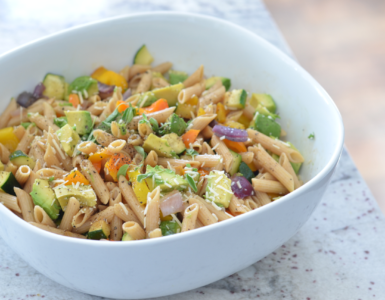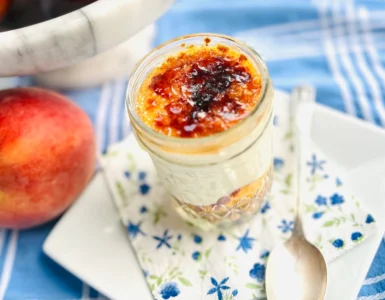These four foods can ease menopause symptoms.
As your hormones change, your food should change, too. Menopause can bring hot flashes, night sweats, and mood swings, but you can manage menopause symptoms with food!
Dietitian Liz Weiss educates us with a few ways you can potentially soothe the symptoms of menopause with your diet.
Find more from Liz on Instagram, @lizweiss, or on her website, www.lizshealthytable.com.
What is Menopause and What are the Symptoms?
By Liz Weiss, MS, RDN
Liz’s Healthy Table
Menopause typically begins when women are in their mid 40s, when estrogen levels begin to decline. Menopause can last anywhere from 4 to 10 years (every woman is different!), and that drop in estrogen can lead to symptoms that may include hot flashes, brain fog, weight gain, insulin resistance, and mood swings.
Hot flashes are the most common menopause-related symptom experienced by women. Hot flashes are defined as a sensation of warmth, often accompanied by sweating, flushing, palpitations, and sometimes anxiety.
Foods that may help with menopause symptoms
Eating a well-balanced diet rich in fruits, vegetables, whole grains, nuts, beans and other legumes (including soybeans), seafood, and olive oil is good for overall health no matter your stage in life. Certain foods within that dietary pattern may be especially important for women in menopause.
- Salmon and other fatty fish: The Dietary Guidelines for Americans recommend eating two seafood meals a week. It’s important to note that fatty fish (salmon, sardines, tuna) contains omega-3 fats, which everyone from children to menopausal women need for brain, heart, and eye health. That said, a 2019 study of women ages 40 – 65 found that the consumption of foods rich in vitamin B6, including fatty fish like salmon and tuna, was associated with a reduction in the severity of hot flashes. Other sources of vitamin B6 include beef, poultry, fortified breakfast cereals, and chickpeas.
- Yogurt, milk, cheese and other dairy foods: During menopause, hormonal changes can lead to significant bone loss, which increases the risk for osteoporosis. (1 of 2 women over age 50 will experience a bone fracture in her lifetime.) Getting enough calcium from dairy and calcium-fortified foods can support bone health. Women between the ages of 19 – 50 need 1,000 milligrams daily and women over 51 should aim for 1,200 milligrams. Your body needs vitamin D to absorb calcium; good sources of vitamin D include fatty fish, egg yolks, fortified breakfast cereal, and sun exposure.
- Tofu, edamame, soymilk and other soy foods: Soyfoods contain isoflavones, natural plant estrogens that may help to reduce the severity and frequency of hot flashes, though research is ongoing. Cooking with tofu, adding edamame to a salad, or drinking a glass of soymilk (or adding to a smoothie) delivers plant-based protein to the diet along with isoflavones and other plant compounds, and together, research shows that soy may also exert other benefits to postmenopausal women including a decreased risk for developing endometrial cancer, reducing the risk of heart disease, and lowering blood cholesterol levels. Exciting new research shows that the consumption of 50 milligrams of isoflavones daily (equal to 2 cups soymilk or 1 cup edamame) reduced wrinkles and increased skin hydration in postmenopausal women.
- Nuts: Whether you enjoy pecans, walnuts, almonds, or pistachios, nuts provide plant-based protein, healthy fats, antioxidants, and fiber. Nuts are satisfying, and eating a handful a day may help with weight control. Research also shows that low to moderate nut consumption – 30 grams or a handful a day – may help to reduce the risk of depression. A handful = 20 walnut halves, 20 almonds, 30 pistachios, 15 cashews.
Citrus Salmon Salad with Edamame, Toasted Almonds, and Feta
Makes 4 Servings
This easy dinner salad checks multiple menopause diet boxes! The salad is comes together quickly with a mound of colorful, crisp greens and then it’s topped with salmon, rich in vitamin B6 and omega-3 fats, edamame (AKA young soybeans) that contain natural plant compounds called isoflavones, and feta cheese, which brings bone-building calcium to the diet.
INGREDIENTS
Citrus Vinaigrette
- ¼ cup to 1/3 cup extra virgin olive oil
- 2 Tablespoons orange juice
- 2 tsp Dijon mustard
- 1 small garlic clove, minced
- Drizzle honey or maple syrup, plus more to taste
- Kosher salt and ground black pepper, to taste
Salad
- 1 Tablespoon reduced-sodium soy sauce
- 1 teaspoon Dijon mustard
- 1 teaspoon mustard
- 1 teaspoon honey
- Kosher salt and ground black pepper
- Four 5-ounce salmon fillets
- 4 packed cups mixed salad greens
- 2 clementines, peeled and sectioned
- 1 cup shelled, cooked edamame
- ½ English cucumber, thinly sliced
- ½ cup crumbled feta cheese
- 1/3 cup toasted sliced almonds
- ¼ cup dried cranberries
METHOD
- Preheat the oven to 425 degrees Fahrenheit. Line a rimmed baking sheet with parchment paper and set aside.
- For the vinaigrette, place the olive oil, orange juice, mustard, garlic, and honey in a jar with a tight-fitting lid. Shake vigorously until well combined. Add salt, pepper, and additional honey or maple syrup to taste. Set aside.
- For the salmon, place the soy sauce, and honey in a small bowl and whisk to combine.
- Lay the salmon on a parchment lined baking sheet. Brush the soy sauce mixture over each salmon filet. Place in the oven and bake until cooked through, 13 to 14 minutes.
- To make the salad, fill four salad bowls evenly with the salad greens. Top each with the cooked salmon, clementine sections, edamame, cucumber slices, feta, almonds, and cranberries. Drizzle with dressing. (Serve extra dressing on the side for additional drizzling).















Add comment